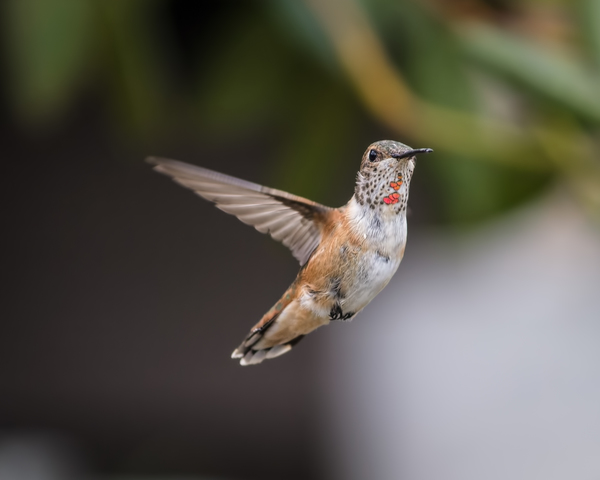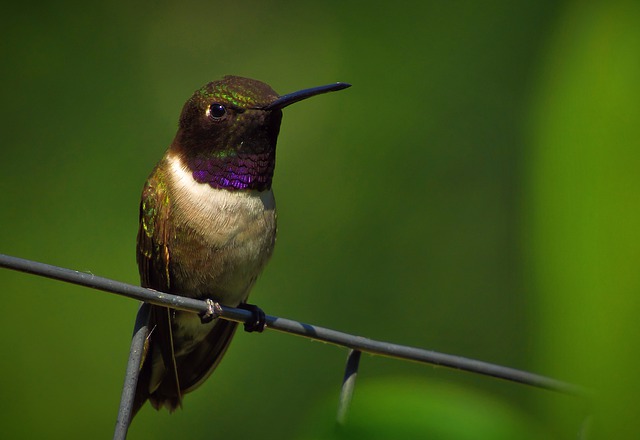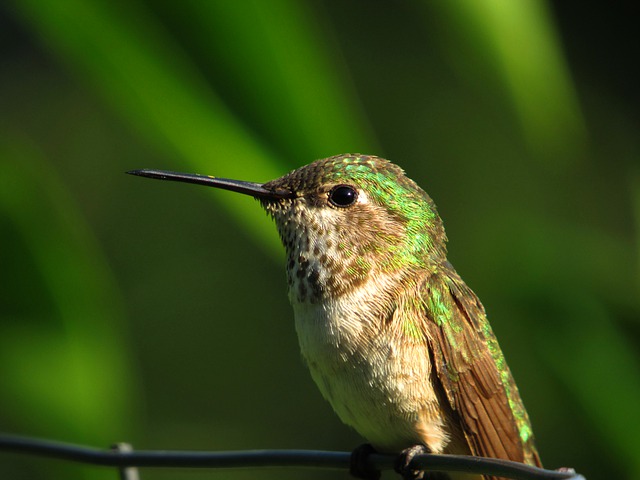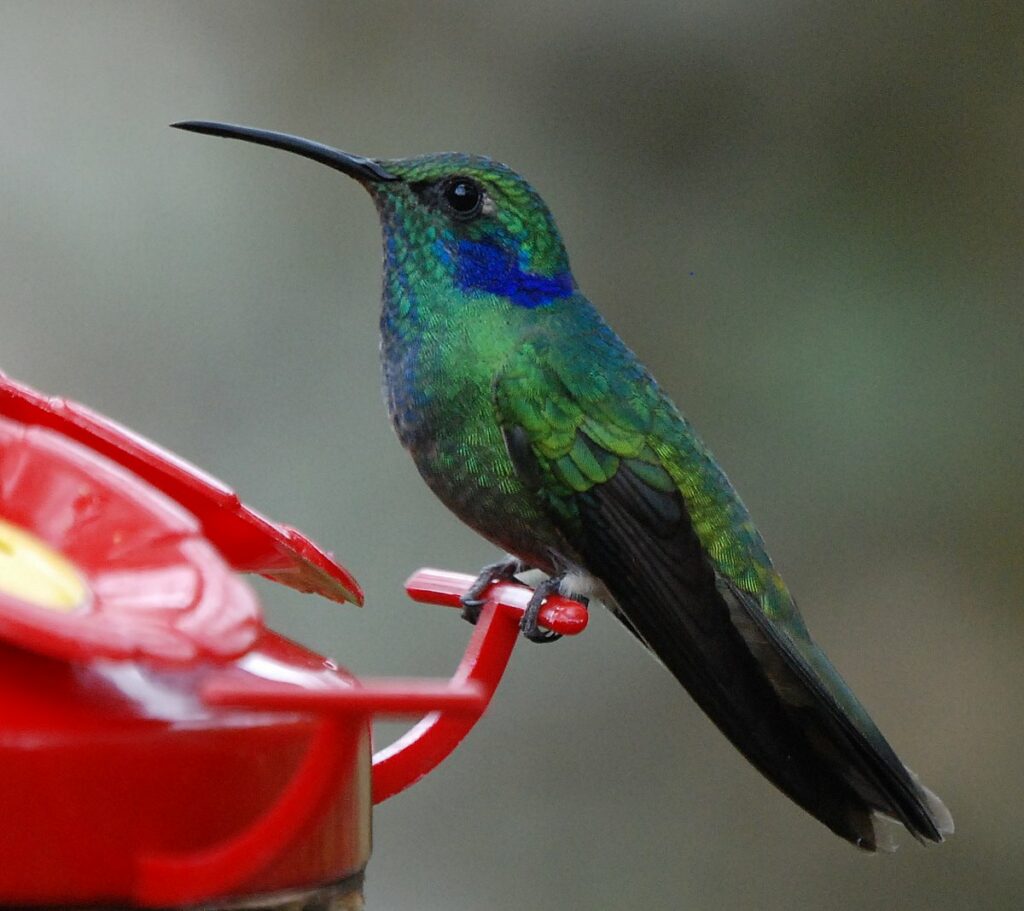In the United States and Canada, roughly 200,000 hummingbirds have been banded since 1954 by a limited number of approved persons. More hummingbirds should be banded, according to the Hummer/Bird Banding Collaborative.
Collaborative members are interested in discovering what is triggering the transition to new habitat as various hummingbird species arrive throughout Ohio winters.
And if you are one of the people who also want to know about different species of hummingbirds in Ohio and how these birds live, then this guide is for you.
| Image | Name |
|---|---|
 | Mexican Violetear |
 | Ruby-Throated Hummingbird |
 | Rufous Hummingbird |
 | Anna's Hummingbird |
 | Black-Chinned Hummingbird |
 | Calliope Hummingbird |
Types of Hummingbirds in Ohio
All of the species of hummingbirds will be discussed today, along with their basic facts.
1. Colibri thalassinus – Mexican Violetear Hummingbird

The Mexican Violetear is one of the largest species, with a length of 9.7 to 12 cm. The average wingspan is 12 cm long. These birds, as their name implies, are common year-round inhabitants of Mexico and the surrounding Central American nations.
Nevertheless, it is known for this hummingbird to go far enough north to reach the United States and even southern Canada.
Appearance
Mexican Violetear Hummingbird males and females share identical coloration. Look for an animal with a beautiful, iridescent green coat and a purple stomach or neck.
The hue of the wing tips varies from a muted brown to nearly black. Their beaks have a very small downward tilt to the bill. They are uncommon to observe in Ohio, but their population is steady.
Habitat
These hummingbirds have evolved to survive in deforested areas and prosper in suburban and urban areas. This bird is widely seen in Mexico and other Central American nations, as its name implies.
These hummingbirds like humid climates and higher elevations in a subtropical setting.
Food
It feeds on nectar and tiny insects, like the majority of hummingbirds, do.
These hummingbirds enjoy eating the highly sugared, vividly colorful subtropical flowers that grow there.
2. Ruby-Throated Hummingbird

In Ohio, ruby-throated hummingbirds are a popular summertime sight. They often begin to migrate in the spring in April, but primarily in May. Up to one or two weeks before the females, males often arrive.
The fall migration typically lasts from September until Mid-October; however, some birds stay around longer. Female Ruby-throated Hummingbirds have white undersides, greenbacks, and brownish crowns and sides.
The best locations to look for them outside in the summer are flowering gardens or woodland margins. They are very widespread in urban areas, particularly around nectar feeders.
The aggressiveness of Ruby-throated Hummingbirds male may be seen in their protection of feeders and flowers. After mating, they do not stay around for very long; by early August, they may have moved away. They produce 1-3 eggs that are only 0.6 inches in diameter (1.3 cm).
Range
The only breed that breeds in eastern North America is the Ruby-throated Hummingbird, which subsequently migrates farther south to Central America.
Some travel across Texas along the coast or over the Gulf of Mexico. They will occasionally rest on a tiny branch, but because of their short legs, they can only shuffle along a perch.
Ruby-throated females construct their nests on slender twigs out of thistle or dandelion down that is bound together by spider silk.
3. Rufous Hummingbird

Although they are uncommon in Ohio, a few rufous hummingbirds do make their way up here each winter. An excellent justification for keeping your hummingbird feeders out throughout the winter.
Appearance
The females have a pale belly and a back that is greenish-brown and rusty in hue. They produce two or three very little white eggs that are 0.5 in (1.3 cm) long.
They are quite hostile and will attack any other hummingbirds that emerge, even bigger ones or those who are resident during migration. They won’t stay around for very long during migration and will often chase off other hummingbirds if they have the chance.
Habitat
They inhabit mountain meadows and, during the winter, woodlands and woods. When compared to their size, Rufous hummingbirds have one of the longest migration routes, covering up to 4000 kilometers each trip.
They move south to Mexico and the Gulf Coast to spend the winter after breeding in northwest Alaska.
Food
The main sources of food for Rufous hummingbirds are nectar from vibrant tubular flowers and insects, including gnats, midges, and flies.
4. Anna’s Hummingbird

Near the western coast of the United States, Anna’s Hummingbirds, which are somewhat bigger than Ruby-throated Hummingbirds, are typically seen throughout the year.
Habitat
An anna’s hummingbird loves to fly across open areas, such as large forests, gardens, and sagebrush deserts. Additionally typical are groves, savannahs, and residential streets.
These events may seem unusual to you, but numerous bird watchers in Ohio have discovered these hummingbirds during the winter months well east of their normal habitat.
It’s interesting to note that feeder visits are highly probable for them. These birds may be seen even in the winter months when no other species are around. These creatures have stocky bodies and large tails that are linked to them.
The majority of these West Coast dwellers are green; however, some have grey bodies. On their heads and necks, the males have shiny reddish-magenta feathers that, in the absence of strong sunlight, might take on a brownish appearance.
They are also appreciated for their powerful vocal powers, moving everyone with a buzzy, metallic tune. When perched, an Anna’s hummingbird’s tail stretches past the tips of its wings.
5. Archilochus Alexandri – Black-Chinned Hummingbird

These are very rare types of hummingbirds to be found in Ohio. In actuality, the first sighting was claimed in 2020. Although this species of hummingbird usually stays in Mexico and the Western United States, it is possible for them to make “accidental” trips to other places.
These hummingbirds have a wingspan of around 9 cm and weigh between 2 and 5 grams. Usually, they have an 11-centimeter wingspan.
Habitat
The Black-chinned Hummingbird can adapt to almost everything. This bird, which dwells in deserts, mountains, and cities, has been often observed throughout the west coast of the United States.
Appearance
The fact that the male and female Black-chinned Hummingbirds belong to the same species may be difficult for you to accept. The males have magnificent purple collars and blackheads.
Their body is an understated blend of white, light brown, gray, and a smattering of mild green. The females are covered in a grayish-white front and a golden-green cloak with brown-tipped wings.
Food
The backyard feeder is no stranger to these hummingbirds. They like chowing down on nectar and tiny insects like gnats and spiders.
6. Calliope Hummingbird

The Calliope hummingbird is the smallest one in the U.S. Wintering in Central America, the calliope hummingbird spends its breeding season mostly in the Pacific Northwest and portions of western Canada, and it may be often found in Ohio.
Males have a distinctive neck pattern with side-forking magenta stripes. The underparts and portions of the neck are speckled with green on the plain-looking females.
This species has the name of Calliope, Homer’s muse. On the east coast, calliope hummingbirds are rare, but they have been seen at least twice in Ohio.
The male Calliope Hummingbird’s neck has some pink threads. The male’s body is light brown and white in color. The back and chest of the female Calliope Hummingbird are bronze and green with a little peach hue.
The Illiad and the Oddesy are claimed to have been influenced by Calliope. The last time one of these little birds was spotted in Ohio was in 2017.
The Calliope Hummingbird has even been observed chasing off birds as big and strong as Red-Tailed Hawks, displaying the sprightliness that most hummingbirds are known for.
Check out this article on Types of Hummingbirds in California and Types of Hummingbirds in Colorado.
Conclusion
This was a discussion on different species of hummingbirds in Ohio, where we have listed the information that you seek. If you need more details on this topic, see our blog.
FAQ
Which hummingbird resides in Ohio?
The sole native hummingbird to Ohio is the ruby-throated hummingbird, which becomes well-known there during its nesting season in late April or early May.
Hummingbirds visit Ohio for how long?
In late August, southern migration could begin. By mid-October, all ruby-throats have disappeared. The bulk of them goes in late September. Males leave first, followed a week or two later by females and young hummers.
What characteristics mark a Black-chinned Hummingbird?
Males have a slender, iridescent base and a velvety, black throat. The neck is paler on females. The flanks of both sexes have a faint metallic green shine. The large white tips on the female’s three outer tail feathers. The bill is dark gray.
When are hummingbirds most active during the day?
Dawn and dusk, or early in the morning and late in the afternoon before sunset, are often when hummingbirds visit feeders and eat on your nectar.
But despite the fact that those two periods appear to be their preferred eating times, hummingbirds can be spotted eating throughout the day.
Is there a red hummingbird?
You may have seen several red-colored hummingbirds in addition to the Rufous Hummingbird, which is the most prevalent red hummingbird.
Some of these hummingbirds, like the Rufous, Allen’s, and Cinnamon, are quite red, while others merely have red on their heads or throats.
Last Updated on March 22, 2023 by Lily Aldrin
